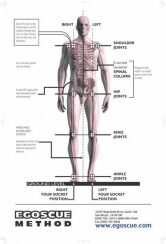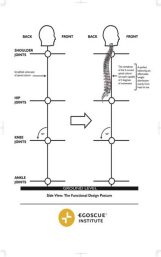Almost all of us will at some point in our lives experience back pain. Chronic lower back pain is a condition that drives most people straight to the nearest physician in search of a solution. Doctors will often prescribe physical therapy to treat the symptom; however, if this doesn’t do the trick, anti-inflammatories, injections, or ultimately surgery are often suggested.
These recommendations “may†reduce the site of the pain, but ultimately do not address the underlying source. I’m not anti-surgery or injections for all situations, but we must begin to recognize that in most cases, chronic back pain is a symptom of musculoskeletal dysfunction that can stem from anywhere within the kinetic chain. We can attempt to fix the pain by getting an injection, removing a disc, or fusing vertebrae, but this will not address what caused the vertebrae to shift or the disc to compress in the first place. Consequently, many people experience relief only to have symptoms reoccur.
There are many terms thrown around in the medical world describing back pain symptoms: Slipped disc, bulging disc, degenerative disc, herniated disc, stenosis, sciatica, spondylolisthesis; but don’t let these terms scare you! These are just names diagnosing conditions which CAN be alleviated when provided with the proper stimulus.
Outside of an acute injury, typically musculoskeletal imbalances are what cause these back pain symptoms. For example, if someone has an elevated hip, this may cause a shift in the spine to accommodate the asymmetrical position of the pelvis. This shift in the spinal vertebrae over time leads to compressive forces on the discs. A disc may then irritate a nerve causing sciatic pain down a leg, as the vertebrae are no longer in alignment. Surgery can remove the piece of disc pressing on the nerve, but it will not address the elevated hip and spinal imbalances that caused the symptom. You can now understand why pain may reoccur in the future regardless of relief from injections or surgery unless you address the underlying cause, being the elevated hip and spinal offset.
Lucky for us, muscles move bones! With appropriate adaptation to stimulus over time we can typically lower that hip back to its neutral position, reduce compensatory patterns, and thereby reduce compression and pain.
One of the most excruciating back pain symptoms is a disc herniation. Discs are the tough pads that act as cushions between the vertebrae. When a disc herniates, it is being squeezed by the bones until it bulges and comes in contact with a nerve causing referred pain. The doctors typically want to remove the piece pressing on the nerve. This is understandable, as it’s causing severe pain; but the important question to ask is, how did it get there? And, can we recreate balance and space for adequate healing to occur? ?
The majority of disc herniations will occur toward the bottom of the lumbar spine at L4- L5 or L5-S1. Typically, the recommended surgery is a microdiscectomy, which is designed to take the pressure off the nerve root. In this surgery, a small portion of the disc that’s pushing on the nerve is removed. Although the surgeon may tell you the success rate of this surgery is about 95%, what they are not telling you is that a small percentage of people experience another disc herniation within a few months; and furthermore, a higher percentage will experience pain symptoms again within a year.
Why would this happen once the piece of disc has been removed and is no longer irritating the nerve root? Once again, the symptom may have been addressed, being the disc pushing on the nerve, but the faulty curvature of the spine and possible rotation or misalignment of the hips, pelvis, and thoracic back remains the same. Any time the body is out of alignment, this causes inefficient movement patterns and ultimately wear and tear at the joints.
Postural imbalances at the load bearing joints will lead to dysfunctional range of motion in the spine, hips, knees, and ankles. Therefore, every time a person with these misalignments bends to pick something up, rather than being able to recruit their large hip flexor muscles, they are forced to overuse the spinal muscles. These muscles are not designed for lifting, and over time there is wear and tear, until “pop,†a disc herniates, bulges, or ruptures.
Some people say you may not completely heal a ruptured disc without surgery; however, when the body is shifted back to its balanced and aligned position, it has capacity to heal, and the disc matter has the opportunity to reabsorb. With time and patience, there is hope of resolving the pain symptoms. Therefore, it makes sense to at least attempt to restore the body’s alignment before rushing into surgery.
Please keep in mind, I’m not implying there is never a condition that warrants surgery. If the pain is too acute you may want to consult with a doctor, but regardless, it’s imperative to address the alignment of the load bearing joints and rebalance muscular tension throughout the body to reduce future wear and tear, whether or not you opt for surgery.
So, in summary, remember the whole body is interconnected, and dysfunction in any of the load bearing joints will have a compensatory effect on the spine; however, there is hope! With a menu of customized exercises designed to restore alignment throughout the body, we have the capacity to reestablish the optimal curvature of the spine, so it can once again act as a natural shock absorber. By increasing our awareness, educating ourselves, and restoring mobility, balance, and alignment, we can regain control of our body and alleviate any current or future pain symptoms.
For a free half hour postural analysis to determine what could be causing your back pain contact Lisa Decker at Aligned Fitness.
Lisa Decker M.S.
PAS, CPT, CES, PES, CAMQ



